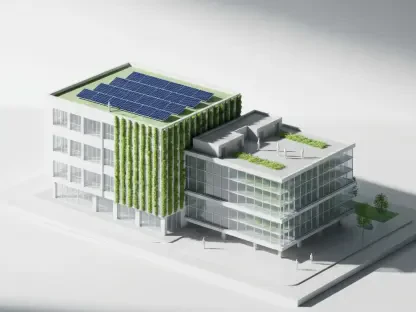Urban centers worldwide are grappling with mounting environmental challenges, including air pollution, shrinking green spaces, and the pressing need for sustainable urban development. Green building techniques offer cities a tangible solution for addressing these issues, improving public health, and combating climate change. This mechanism of transforming urban landscapes is not just a theoretical construct but a practical, necessary evolution that cities must undertake to thrive in an ever-warming world. The journey of Valentina Casab-Klescova, who navigated the choked air of Mexico City and envisioned cleaner, healthier urban environments through strategic urban planning, underscores the importance of such initiatives. Her research and senior project make a compelling case for cities like Singapore and Barcelona, which have pioneered successful green design frameworks, proving that urban metamorphosis on a global scale is possible.
Successful Green Building Case Studies
Singapore and Barcelona serve as exemplary models of how urban centers can integrate green building techniques to foster healthier and more sustainable environments. Singapore, often dubbed “The Garden City,” has been a leader in urban sustainability efforts since it gained independence. The city-state is committed to greening at least 80% of its buildings and expanding green spaces by 2030 and 2035, respectively. This bold vision underscores a synergy between economic development and ecological preservation, illustrating how modern cities can thrive without sacrificing environmental integrity. In contrast, Barcelona has introduced innovative strategies through its 2023 Eixos Verds proposal, which reimagines urban spaces by creating “superblocks” with increased green areas and reduced roadways. This strategy focuses on enhancing mental health while minimizing noise and air pollution. Each city’s distinctive approach offers valuable insights into urban planning that accommodates both environmental needs and human health, demonstrating that despite differing histories and challenges, the adoption of green urban development is far from unattainable.
The success of these programs lies not only in infrastructure changes but also in their impact on the well-being of urban residents. The constructive relationship between urban greenery and public health is increasingly supported by data showing improvements in air quality, reductions in urban heat, and enhanced mental well-being among inhabitants. By prioritizing green spaces, cities can counteract the adverse effects of urbanization while cultivating environments that foster physical health and psychological resilience. These examples demonstrate that robust ecological strategies are executable in varied urban settings, offering frameworks adaptable to many global cities. The willingness to invest in such transformations can lead to significant enhancements in quality of life, showcasing how cities, regardless of initial ecological baselines, have the capacity to turn urban areas into sustainable havens.
The Role of Academia and Personal Journeys
Universities play a pivotal role in nurturing the next generation of leaders who are equipped with the knowledge and passion to drive urban environmental change. At institutions like Pacific University, students are immersed in comprehensive curriculums that blend sustainability with international perspectives. Casab-Klescova’s academic journey, characterized by study abroad experiences in Australia and Costa Rica and leadership in sustainability initiatives, illustrates the multidimensional education that empowers individuals to envision and implement transformative green strategies. Through academic programs and hands-on experiences, students are inspired to pursue ambitious projects, like Casab-Klescova’s “Making Every City A Green City.” Such endeavors not only solidify theoretical knowledge but also foster practical skills essential for real-world application and innovation.
Beyond the confines of academic learning, personal journeys significantly shape the aspirations and career paths of graduates aiming to influence urban environments. Post-graduation plans, like Casab-Klescova’s intention to travel during a gap year, offer opportunities for broader exploration into environmental policy, management, or design. Such experiences allow individuals to refine their vision, cultivate global partnerships, and gather diverse insights that can be synthesized into effective urban planning solutions. The culmination of educational and personal ambition, coupled with global exposure, empowers future professionals to contribute to comprehensive urban sustainability initiatives and guide cities toward ecological transformations that benefit citizens and the environment alike.
Future Prospects and Global Implications
Singapore and Barcelona epitomize how urban areas can embrace green building methods to create sustainable and healthier living spaces. Singapore, known as “The Garden City,” has prioritized urban sustainability since independence, aiming to green 80% of structures and expand greenery by 2030 and 2035. This strategy merges economic progress with ecological preservation, proving cities can advance while maintaining environmental integrity. Conversely, Barcelona’s 2023 Eixos Verds proposal restructures urban zones with “superblocks” to increase green spaces and cut down roadways, promoting mental health and reducing noise and pollution. Each city’s unique plan provides lessons on urban development, addressing environmental and human health, and showing how green urban growth is attainable despite varying historical contexts. These initiatives impact infrastructure and resident health, enhancing air quality and mental well-being. Prioritizing green spaces can offset negative urbanization effects, showcasing cities’ ability to transform into sustainable sanctuaries worldwide.









